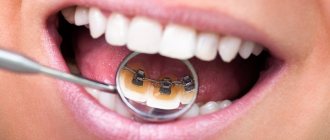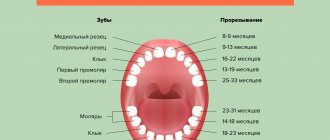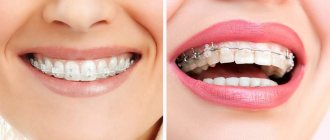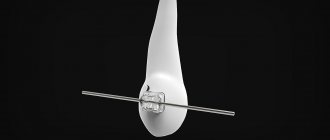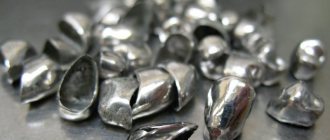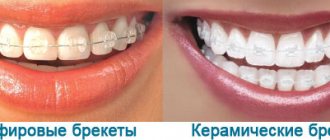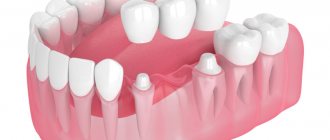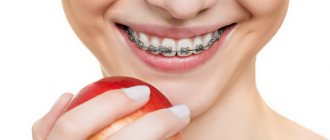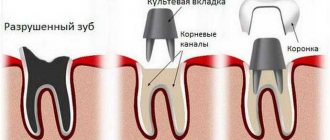Orthodontists always require that decay on all teeth be treated before putting on braces or aligners. This applies even to superficial or fissure caries (those that occur in the recesses of the masticatory tubercles). If you have bad teeth, the doctor will not attempt to correct your bite.
The first thing the orthodontist will recommend is to cure caries
What do braces fix?
Braces are used to correct bites and eliminate various pathologies. Among the indications:
- malocclusion – problems with the closure of the dentition;
- disproportionate development of the jaws;
- displacement of individual teeth beyond the jaw row;
- jaw deformation during formation;
- large gaps between teeth.
Many bite problems are visible even to non-professionals, but some anomalies will only be noticed by a specialist. Dentists strongly recommend that you periodically show your child to an orthodontist to monitor the change of teeth, evaluate the growth of the jaw bones, and monitor the work of the facial muscles.
Ultimately, it is the patient who decides whether to remove wisdom teeth.
Let us immediately make a reservation that when drawing up a treatment program, the orthodontist is guided not by his own desires, but by the picture obtained during the diagnosis.
Wisdom or figure eight teeth can indeed cause the development of some dental defects. But due to a number of features, the process of removing them is a very traumatic procedure. It is quite difficult for a person to part with even one “eight”, and if we are talking about two or four, not everyone will want to continue talking about orthodontic treatment. Therefore, when announcing the need for surgical intervention, the doctor takes on great responsibility and, accordingly, carefully weighs the pros and cons.
In addition, no patient’s teeth have ever been forcibly removed in orthodontist centers in Moscow. If the logical justification for this procedure seems unconvincing to you, you may well consult with one or two more specialists.
At what age are braces installed?
Braces are usually placed on teenagers aged 12-14 years. During this period, active formation of the bite and replacement of teeth occurs, which makes the treatment effective. The correction period takes 1-2 years, and the result lasts for life.
In rare cases, the time frame is shifted. Braces are placed on children:
- 8-11 years old – use a simplified system to correct the growth of the front teeth;
- 15-16 years old - according to indications and with the consent of the teenage patient.
Soldatenkova Alina
Orthodontic treatment with braces is popular today among adults.
But this is not a reason to delay the correction. We explain to patients: if the period of wearing braces in adolescents is one or two years, then in adults this period increases significantly.
Does installation and wearing hurt?
Of course, there are discomforts. In particular, they are caused by the archwire inserted into the braces. There is also discomfort when moving teeth. But there is no pronounced pain that prevents me from speaking, eating, sleeping and preventing me from living normally. First of all, because the force of the arcs is strictly dosed. All movements occur gradually, with a step-by-step increase in the power and size of the arcs - from weaker to stronger, from round to faceted, from thin to thick (full-groove). As for unusual tooth movements, this is a matter of habit, which will appear in 1-2 months.
Let us remind you that all the discomfort during treatment comes down only to the peculiarities of nutrition and brushing your teeth. In the first case, a certain revision of the diet is required, with the rejection of certain foods, and in the second, strict self-discipline. That's all the “inconvenience”.
What teeth are they placed on and what types of braces are there?
The classification of bracket systems is varied. The designs differ in materials, method of arch attachment, and location in the mouth. The following devices deserve interest:
- Vestibular – external braces for installation on the front (visible) surface of the teeth. When choosing this system, it is important to evaluate the characteristics of the material used, as it will determine the aesthetics and wearing comfort.
- Lingual - the structure is fixed on the lingual (inner) side of the dentition, which makes it invisible to others.
Based on the method of fastening the arch in braces, the following models are distinguished:
- ligature - fixation of elements among themselves is carried out using ligatures (rubber bands or small wires);
- non-ligating (self-ligating) – the power arc is tightly or loosely attached to the locking grooves of the plates.
When installing braces, the orthodontist will use the entire dentition - some of the plates will be visible in the smile area, the other part will be placed in an invisible area on the distant teeth. The material from which the braces are made will determine the aesthetics and will also affect the wearing comfort. Possible options:
- Metal ones are inexpensive and have been repeatedly tested in orthodontic treatment. They are capable of correcting even severe pathologies, but are not without drawbacks. Metal is more damaging to the mucous membrane when worn than other materials; it is unsightly and noticeable on the teeth.
- Ceramic – made to match the color of the enamel, they are practically invisible on the teeth. They cope well with correction, but are fragile and require care when worn. Due to the strength characteristics and the ability to be stained by food, certain restrictions are introduced into the patient’s eating habits.
- Sapphire - transparent and durable, do not change color from bright drinks and dishes. The most expensive of all designs, valued by teenagers and adults for their exceptional aesthetics.
- Plastic devices are short-term wearing devices, as they are unreliable, fragile and impractical.
Plaksina Margarita
For teenagers, I recommend the installation of combined braces - the visible part is made of an aesthetic material (sapphire, ceramics), and metal on the distant teeth. This combination gives optimal results and avoids the development of complexes in children.
What if there are already so many fillings?
Braces or aligners can be worn on treated teeth if the fillings are installed well. The service life of a filling can be up to 10 years or more. If the patient has older or decaying fillings, they will need to be redone.
The number of fillings does not affect the process of correcting the bite, even if they are on the front surfaces of the teeth where braces are installed (if we talk about treatment using a fixed structure). Also, “dead” teeth with removed nerves and sealed canals will not interfere with the process.
Installation of braces: preparatory stage
Before directly attaching braces to the teeth, the patient will have several meetings with the orthodontist. The preparation algorithm includes:
- A visual assessment of the condition of the oral cavity, during which the doctor examines the proportions of the face, the position of the teeth in the jaw, the structure of soft tissues, bones, and the general condition of the teeth.
- Diagnostic studies. X-rays, OPTG, CT show a complete picture of the oral cavity - the position of the roots, the presence of the rudiments of permanent teeth, if the correction is started before the complete change of bite. The orthodontist also takes several photos of the patient’s face from different angles. This helps the doctor see how much symmetry is broken and take this fact into account when drawing up a treatment plan.
- Surgical stage. It is carried out only when absolutely necessary and comes in two versions. The first is tooth extraction. Dentists strive to preserve every unit of bite, but sometimes this is not possible. Frequent causes of malocclusion are crowded teeth, supernumerary teeth, and in these cases, extraction cannot be avoided. The second reason for surgery is problems with the frenulum. If the frenulum is the culprit of the malocclusion, then plastic surgery is performed.
- Therapeutic stage. Braces are placed only on healthy teeth. This means that tooth decay and other diseases must be cured. Sanitation of the oral cavity is carried out several days before installing braces on the teeth, so that the fillings allow natural shrinkage, the gums and mucous membranes are restored.
- Professional cleaning – removing plaque and tartar. Before installing braces, the enamel of teeth is cleaned for better bonding of surfaces.
- Taking impressions of the jaws. This step is necessary for computer modeling of the correction process and drawing up a treatment plan.
Consequences of malocclusion
First of all, defects affect the patient’s self-confidence and problems arise from an aesthetic point of view. Also, incorrect position of teeth relative to each other can cause poor oral hygiene, which will cause plaque and food particles to accumulate in hard-to-reach places. As a result, more serious diseases may develop, such as caries or tissue inflammation.
The most dangerous consequences in the absence of timely medical intervention include the following: strong breath, loss of one or more row units, severe bleeding, pain and sensitivity, reaction to cold or hot food, and much more.
What are the causes of malocclusion? As a rule, this problem is hereditary in nature or its cause lies in early childhood. Risk factors include constant thumb sucking in infancy, the use of pacifiers and bottles, especially those with an anatomically shaped nipple. It is very important to show your child to the dentist before the age of 5, until the bite is completely formed and can be easily corrected.
How to put braces on teeth: direct and indirect methods
The next step in working with patients is directly fixing the braces. They do this in one of two ways:
- direct - a classic option used in every dental clinic;
- indirect - a progressive method that is gaining popularity.
A video on installing braces traditionally introduces the direct fixation method:
Direct method of installing braces
The orthodontist glues braces to each tooth one by one, based on a panoramic photograph of the jaw and the calculations made. The work is jewelry, highly precise, requiring care and concentration.
Stages of fixing the bracket system in a direct way:
- Installing an expander into the patient's mouth so that the orthodontist can clearly see and have access to all teeth.
- Fixation of orthodontic rings to the outermost units - “sixes” or “sevens”. The rings will serve as reference points for the entire system.
- Additional cleaning and polishing of tooth enamel to remove the smallest plaque particles.
- Drying the teeth with an air jet and insulating the tongue with a special “plug”.
- Application of components of an adhesive system to the teeth and plates, which, under the influence of ultraviolet radiation, will ensure the strongest fixation of each bracket.
- Cementing the rings on the outer teeth and passing a metal wire through each clasp is activating the braces.
- Removing excess orthodontic arch wire with nippers.
- Freeing the oral cavity from the dilator and tongue-fixing device.
First of all, braces are placed on the upper jaw and only then on the lower jaw. For the convenience of the patient, appointments can be spaced out in time so that there is an opportunity to adapt to wearing braces.
Devices are rarely attached to only one jaw - these are rather exceptional situations than everyday practice.
Indirect method of fixing the bracket system
This algorithm differs from the previous one in that part of the work is carried out outside the patient’s mouth.
In a dental laboratory, a technician uses dental impressions to make a plaster model. On it, the doctor places the locks at precisely calculated points and connects them with a metal arc. Afterwards, the resulting system is transferred to a mouthguard and placed on the corrected dentition. This allows you to fix the entire structure at once - quickly and comfortably for the child.
What to put on the upper jaw and what on the lower jaw?
You can place both identical and different jaws on 2 jaws: one type on the upper dentition, and the other on the lower dentition. A simple example. If the upper teeth are more visible when smiling and talking, then aesthetic structures made of ceramics or sapphire are placed on them. Metal ones are installed on the lower teeth, which are almost invisible when opening the mouth. In addition, it will be more affordable, since a metal bracket system is cheaper than an aesthetic one.
The main thing when installing different systems on both jaws is the absence of “technical differences” between them, that is, inconsistencies in parameters. Therefore, it is better to use products from the same manufacturer.
During a direct examination by a specialist, you will be able to find out your exact diagnosis, as well as receive a referral for diagnosis or a treatment plan.
Life with braces on teeth: adaptation and care
The secret to the effectiveness of braces is the gradual movement of teeth at the level of the root system. The units move from the pathological position to the correct one, but this transition is associated with slight discomfort for the patient.
The sensations are especially unpleasant in the first days after activation: the teeth ache and even hurt. This is an adaptation period, and it lasts differently for children. Usually a week or two. Then the teeth get used to micro-movements, and the child stops feeling the braces in the mouth.
But the question of care remains open. The orthodontic design consists of many elements - with an abundance of niches, corners, and difficult-to-clean areas. Therefore, you have to devote a lot of time to caring for braces every day - 15-25 minutes twice a day. During the care process, teeth and system elements are cleaned one by one:
- orthodontic brush with V-shaped bristles;
- mono-beam brush;
- pipe cleaners;
- dental floss.
It is good to additionally use special toothpastes for patients with braces, an irrigator and a mouth rinse.
If everything is done correctly and according to the prescribed algorithms, then treatment with braces will not leave any unpleasant memories, and your teeth will acquire a straight and beautiful appearance.
How long should you wear partial braces?
In adults, the period of use of partial corrective structures ranges from 6 months to 10 months; for a child, it can last for two years until all permanent teeth appear. For the effectiveness of treatment and timely adjustments when wearing partial braces, it is necessary to visit the orthodontist once a month. If you ignore this rule, you may end up not getting the effect of wearing braces: money and time will be wasted.
Before installing partial braces, the condition of the teeth and gums must be in perfect order: all dental diseases have been cured and hygienic cleaning has been carried out. Any braces systems are installed only in a healthy oral cavity.
Absolute contraindications
These are those in which correcting the bite is either impractical or impossible.
- Most of the teeth are missing.
If the chewing teeth on both sides of the upper and lower jaws have been destroyed, removed or missing, then it often makes no sense to correct the position of the remaining ones. When preparing for prosthetics, the doctor will most likely offer an alternative option.
If you have only a few teeth, braces cannot be installed.
- Dystrophic processes in the jaw bone, periodontal disease.
Bone atrophy or thinning are synonymous. The essence of the process is that bone tissue cells are not renewed, the volume of the bone gradually decreases, the roots of the teeth begin to stay in it worse and can become loose. This process requires supervision by a dentist or periodontist, since with due attention to your health, you can slow down the development of the disease and save your teeth. But treatment by an orthodontist, which is accompanied by a strong impact on the roots of the teeth, is no longer carried out.
It is possible to correct a bite if the tissue of the jaw bone is dense and holds the roots of the teeth well.
- Several implants.
Even one implant puts the possibility of correcting the bite into question, since usually when wearing braces or aligners, all teeth move to one degree or another. And if there are several implants, it is impossible to avoid pressure on them. Unlike tooth roots, implants are not able to withstand such a load.
The generally accepted procedure is: first treatment with an orthodontist, and only then installation of implants.
Temporary contraindications
These are the ones that are easy to fix. Having identified them during the examination, the orthodontist will give recommendations, and soon after treatment it will be possible to begin correcting the bite.
- Caries.
When wearing any orthodontic structures, plaque forms much faster, and it is more difficult to clean it. Although braces and aligners themselves do not cause caries, attention to hygiene during orthodontic treatment should be much higher. Therefore, removal of all foci of caries, including superficial ones, is an indispensable condition before starting treatment.
- Plaque, tartar.
The reasons are the same as described above. The bite is corrected with perfectly clean teeth. To prepare, it is enough to undergo ultrasonic cleaning (it perfectly removes hard plaque) and air flow (removes soft plaque).
Those who want to correct their bite should get used to more careful dental care. This is a great habit that will help you stay healthy for many years and avoid prosthetics in the future.
- Inflammation of the gums.
Minor inflammation may occur due to accumulated soft plaque. After professional dental hygiene, as a rule, it is enough to follow the doctor’s recommendations for several days (usually the use of local antiseptics) to eliminate the problem.
Types of plastic braces
Manufacturers of bracket systems offer a wide selection of designs, but dentists in practice often use 3 types, which are durable, reliable, and have good aesthetic properties.
- Elan - are distinguished by a special relief that follows the surface of each tooth. They secure the bracket well to the tooth enamel and have a metal frame, which increases the strength of the entire structure.
- Spirit - consist of a metal groove that improves the sliding of the arc, which eliminates abrasion. Such designs have a snow-white tint, but they are not suitable for patients with yellow teeth or deep bites.
- Silkon - made from non-porous material, eliminates friction of the arc during movement, which allows you to increase the effect while wearing.
The attending physician decides together with the patient which type of plastic installations to choose to eliminate dental defects. A specialist, in accordance with the structural features of the jaw system, will select the best option and give recommendations on how to care for the device, which will increase its service life and improve the quality of service.
Not a contraindication
- Childhood.
The whole question is which method of treatment to choose. For younger children, removable aligners are often chosen, and teenagers can wear the same aligners as adults. But you can start correcting your bite immediately after diagnosing the existing problem at any age.
- Older age.
There is no upper age limit. If your teeth are preserved and there is a need to correct their position, you can be treated by an orthodontist at any age.
- General diseases (with very rare exceptions).
Metabolic disorders, asthma, allergies and other systemic diseases almost never interfere with wearing orthodontic structures, since the materials are hypoallergenic, and no surgical intervention (as when installing implants) occurs. If the patient's general condition is satisfactory and he can visit the clinic, then most likely there are no obstacles.
Correcting your bite will not only give you a beautiful smile, but will also prevent many problems with your teeth and the health of your body in general. If you are unsure whether you can undergo orthodontic treatment, please contact your orthodontist and ask all your questions.
More articles on the topic:
- Can veneers correct crooked teeth?
- Reflections ceramic braces: advantages and features
